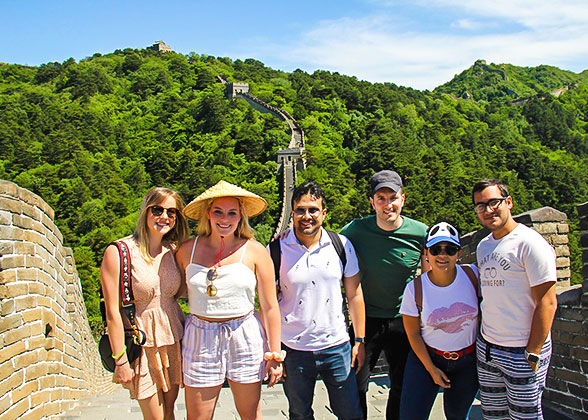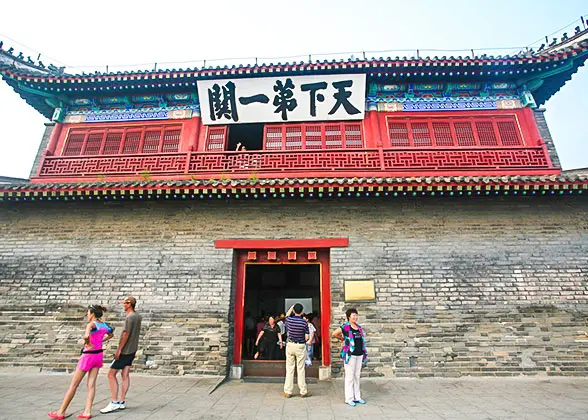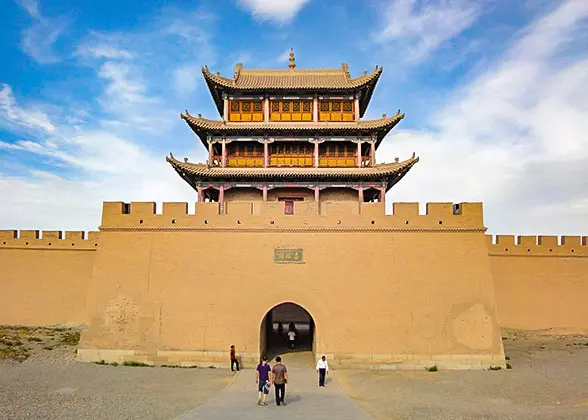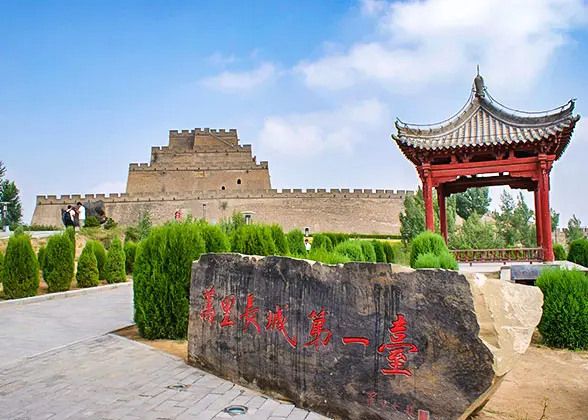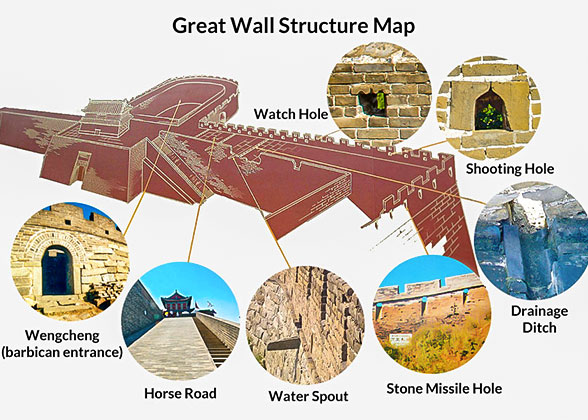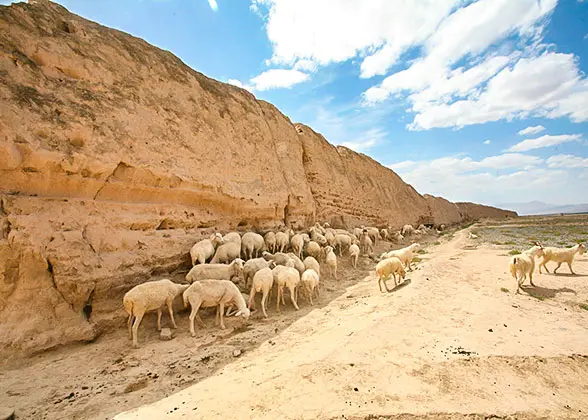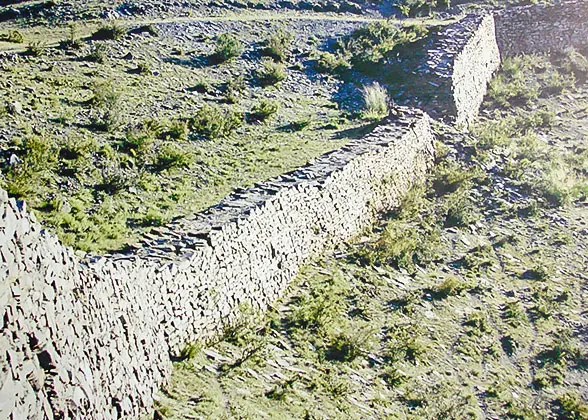Fun Facts about Great Wall: 25 Things You didn’t Know
Chinese Name: 长城 (cháng chéng), 万里长城 (wàn lǐ cháng chéng), literally meaning ‘The Long Wall of 10,000 Miles'
English Name: Great Wall of China
The Great Wall of China is the longest man-made structure in the world. Traversing northern part of the country, what was a huge military line of defense in the past has now become a unique world heritage site and a symbol of China. The following 10 vital statistics and 15 fun facts reveal a Great Wall hitherto unknown to you.
10 Interesting Figures of Great Wall
1. With a total length of 21,196.18 km (13,170.70 miles), equal to half the length of the Equator, the Great Wall of China is the longest feat of human engineering.
2. In the main today’s wall comprises relics from the Ming Dynasty (1368 - 1644), measuring 8,851.8 km (5,500 miles).
3. The average height of the walls is 6 to 7 meters (20 to 23 feet), and the highest is 14 meters (46 feet ).
4. The altitudes of the walls vary – the highest point is the Huanglouyuan in the northwest suburb of Beijing, with an elevation of 1,439.3 meters (4,722 feet), while the lowest point is at Laolongtou in Hebei, just above the sea level.
5. The average width is 6.5 meters (21.3 feet).
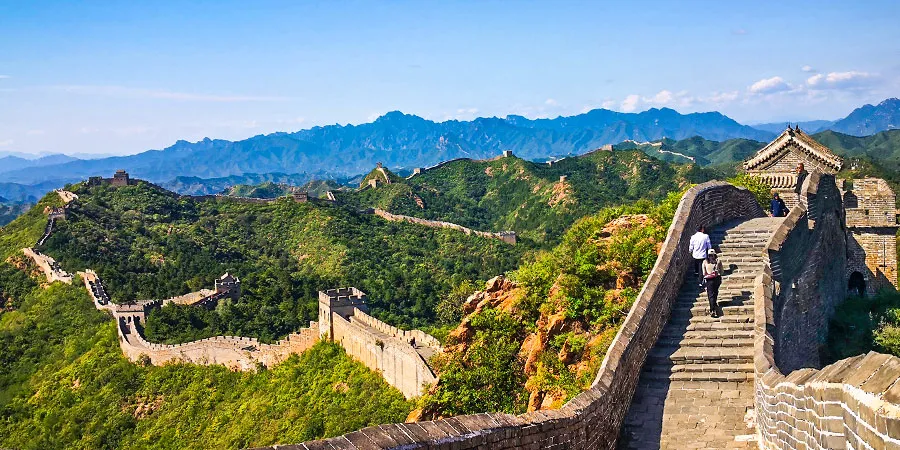 |
| Badaling, Beijing |
7. More than 1,000, 000 laborers were recruited for the construction of this huge project.
8. Location: It spans across 15 regions in north China: Heilongjiang, Jilin, Liaoning, Inner Mongolia, Beijing, Tianjin, Hebei, Shandong, Henan, Shanxi, Shaanxi, Gansu, Ningxia, Qinghai, and Xinjiang.
9. 1/3 of the walls have disappeared.
10. As a must-see in China, it attracts 50 million visitors every year, and had been visited by more than 460 state heads and VIPs from around the world.
How long is the Great Wall of China?
Where is the Great Wall of China located?
You May Like
Top 15 Great Wall Facts
1. First and Last Construction (7th century BC - 1878)
There is a wide misconception that the Great Wall was built under the order of Emperor Qin Shi Huang (259 - 210BC), but it is not true. The fact is that the initial construction was 2,700 years ago during the Spring and Autumn Period (770 - 276BC). The fortifications built by Chu State during the 7th century BC have been proven to be the earliest Great Wall. The last construction was in 1878 in the late Qing Dynasty.
2. Not One Consistent Wall, but a Collection of Walls
The structure is not in a single long line! In fact, there is not one wall, but many walls, in the plural. It is a defensive network consisting of many walls and forts built in different historical periods, with some segments scattering while some running parallel. In some places, the wall doubles or even triples itself.
3. Completion of Such a Massive Project Originated from a Rumor
Emperor Qin Shi Huang is often referred as the initiator of the Great Wall. Actually it was he who first commanded the linking of the separate sections built by previous states. It is surprising to know that the decision for this huge project was made due to a rumor! After unifying central China and establishing the Qin Dynasty in 221BC, Emperor Qin Shi Huang wanted to consolidate his power and rule the country forever. He sent a necromancer named Lu Sheng to seek for a way of immortality. After countless empty-handed returns, Lu finally brought back a rumor that Qin would be overturned by the northern nomads. Hearing that, the Emperor was so frightened that he immediately issued an order to connect the walls and extend new ramparts to guard the northern border.
|
|
4. The Great Wall You See Today is not as Old as You Think
During the 2,500 years from 7th century BC to 19th century AD, more than 20 dynasties and states had undertaken the construction of the walls, section by section, bit by bit. Today’s best-known and best-preserved walls were results from the Ming Dynasty’s massive construction begun around 1381. The Ming Great Wall wound its 5,500 miles’ (8,851.8 km) course from Hushan in the east to Jiayuguan in the west. Many of its sections have been renovated and developed into tourist resorts, such as Badaling and Mutianyu in Beijing, Shanhaiguan in Hebei, and Jiayuguan in Gansu. These sections that are popular with tourists are generally 400 to 600 years old.![]() See more about the construction history of different dynasties.
See more about the construction history of different dynasties.
5. Famous Badaling Vs. Nameless Wild Walls
Large crowds of visitors converge on Badaling, the most well-known section 40 miles (70 km) northwest of Beijing. With best-preserved walls, stunning scenery and consummate facilities, it is the earliest section open to tourists and enjoys the highest international reputation. Out of the halo, there are many other sections of the ancient walls lying wild and nameless. In fact, the countless dilapidated sections form the majority of the entire wall.![]() See more about the Badaling Facts and History.
See more about the Badaling Facts and History.
6. Is it just a ‘Wall’?
It is named a ‘Wall’, but actually it is not only a simple ‘Wall’. Historical facts show that it was a comprehensive fortification, consisting of overlapping walls and trenches for blocking enemies, watchtowers and beacon towers for signals and communication, fortresses for head-on battles, and barracks to accommodate soldiers. During the Ming Dynasty, a well-designed array of fortifications such as the Three Inner Passes of Daoma, Zijing, and Juyong, and the Three Outer Passes of Pianguan, Ningwu, and Yanmen, formed a solid defense for the capital city of Beijing.
|
|
7. It was not Built for Beating back Mongols
The wall construction commenced in the 7th century BC and was first linked up to a defensive line in around 210BC, much earlier before the rise of the Mongols in 11th century AD. The original purpose was to defend against incursions by northern nomadic tribes living in today’s Mongolia and north China, including successively the Hun, Xianbei, Rouran, and Tujue. Some states also built walls to repel their neighbors.
8. It didn’t always Succeed in Keeping out Invasions
For thousands of years, the Great Wall to some extent acted like both a physical and mental barrier between the central Chinese Empire and the barbarian northern nomads, but this only worked for the underdog. Several strong nomadic tribes in history had managed passage across the barrier. For instance, in 13th century, the Mongols led by Genghis Khan breached the wall and subjugated north and central China for nearly 100 years; in 1644, the Manchus’entering from Shanhaiguan resulted in the collapse of the Ming Dynasty.
9. Can it be Seen from the Space?
In early 19th century, the immense scale of the Wall had once given rise to a rumor that it could be seen from the moon with naked eyes. In fact, it is invisible from the space. Difficulty in observing the wall with unaided eyes from space equals that of seeing a hair from two miles away!![]() Further Reading: Can the Great Wall be Seen from the Space?
Further Reading: Can the Great Wall be Seen from the Space?
10. 1/3 of the Wall has Disappeared
The Great Wall is changing all the time; to be specific - it is disappearing year by year. Be clear that well-maintained sections like Badaling are just a few rare exceptions. The fact is that many wall sites had fallen into disrepair and are in danger of being lost due to physical weathering and human activities. Human vandalism is the major threat. According to statistics from UNESCO, nearly one third of the walls have already disappeared. What survive today are mainly the stone and brick constructions from the Ming Dynasty. Early walls made of rammed earth, particularly those in Inner Mongolia, Gansu and Ningxia in northwest China, are deteriorating quickly, cracking, leaning or collapsing. It is estimated that without effective conservation, these sections will disappear altogether within 30 years.![]() See more about Current Situation of the Wall.
See more about Current Situation of the Wall.
|
|
11. Huge Man-Made Damage since the 1960s
During the Cultural Revolution from 1960s to 1970s, miles of the Wall were vandalized or destroyed to make way for infrastructure construction. Many bricks were moved to build civilian houses or farms. From 1980s to 1990s, some people even pillaged the bricks and sold them. It was common to see the ramparts being reduced to give way to road or factory construction. There was no clear regulation on the conservation of the Wall until 2006.
12. The Wall is Sadly Called the Longest Cemetery in the World
In 2,500 years of construction history of the massive project, more than 1,000, 000 laborers had been used, including civilians, soldiers, and convicts. It was a special punishment for convicted criminals during the Qin (221 - 207BC) and Han (202BC - 220AD) Dynasties. The toilsome work took many lives. It is estimated that around 400,000 builders were died and some are said to be buried in the long wall. That gives the dreadful saying of the ‘longest cemetery’. Don’t worry! So far, there has been no actual evidence of the walls containing corpses.![]() See more about the Labor Force.
See more about the Labor Force.
13. Most Widely-Spread Legend – The Cry of Meng Jiangnu
A tragic trivia is known to every household in China. Once there was a woman named Meng Jiangnu, whose husband Fan Xiliang was forcibly recruited to help build the Great Wall just three days after their marriage. Meng missed her husband so much that she decided to visit him. When she arrived at the building site, she was informed that Fan had died of exhaustion and been buried inside the wall. She was heart-broken and cried day and night. Finally, the wall collapsed and exposed her husband’s bones.![]() See more about the story of Mengjiangnu's Bitter Weeping.
See more about the story of Mengjiangnu's Bitter Weeping.
14. Westerners' First Acquaintance with the Wall in 4th Century
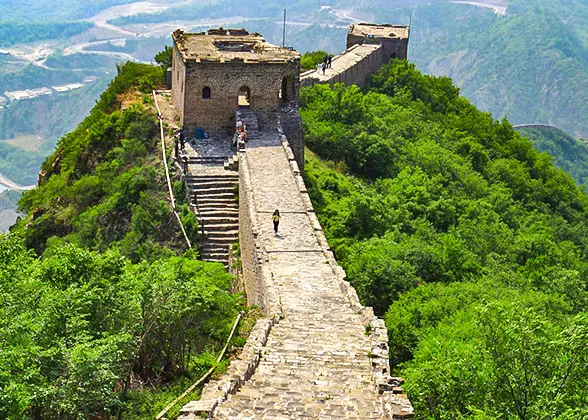 |
| Simatai, Beijing |
In 1987, the Great Wall was designated as a UNESCO World Heritage site. Today, it is recognized as the emblem of China and attracts numerous international visitors. However, before the 20th century, it was seldom described in any Chinese artwork. To the contrary, a simple description about this wall can be found in historical materials of the ancient Rome early in the 4th century. Since the Ming Dynasty, this great architecture was gradually known by more Westerners. In a Portuguese writer's book '1563 Asia', it said that there was a long and solid wall in China with heavy garrison. In 1575, a Spanish envoy also commended the grand wall when he got back to Europe. In 1793, a British painter's picture marked the first appearance of the Great Wall in Western paintings. Since 20th century, the Wall gradually won popularity among tourists.![]() Further Reading: When Did the Great Wall Become Famous?
Further Reading: When Did the Great Wall Become Famous?
15. Special Binding Agent from Grain
The building materials of the walls included the rammed earth, bricks, stones and rocks. What was the mortar? Here comes a fun fact - it was totally different from the modern mixture of sand and cement, as it included glutinous rice flour. Processed rice flour served as a reliable adhesive.![]() See more about the Construction Materials.
See more about the Construction Materials.
Further Reading:
Great Wall of China Facts for Kids
Great Wall of China FAQs
Great Wall of China - One of the 7 Wonders of the World



